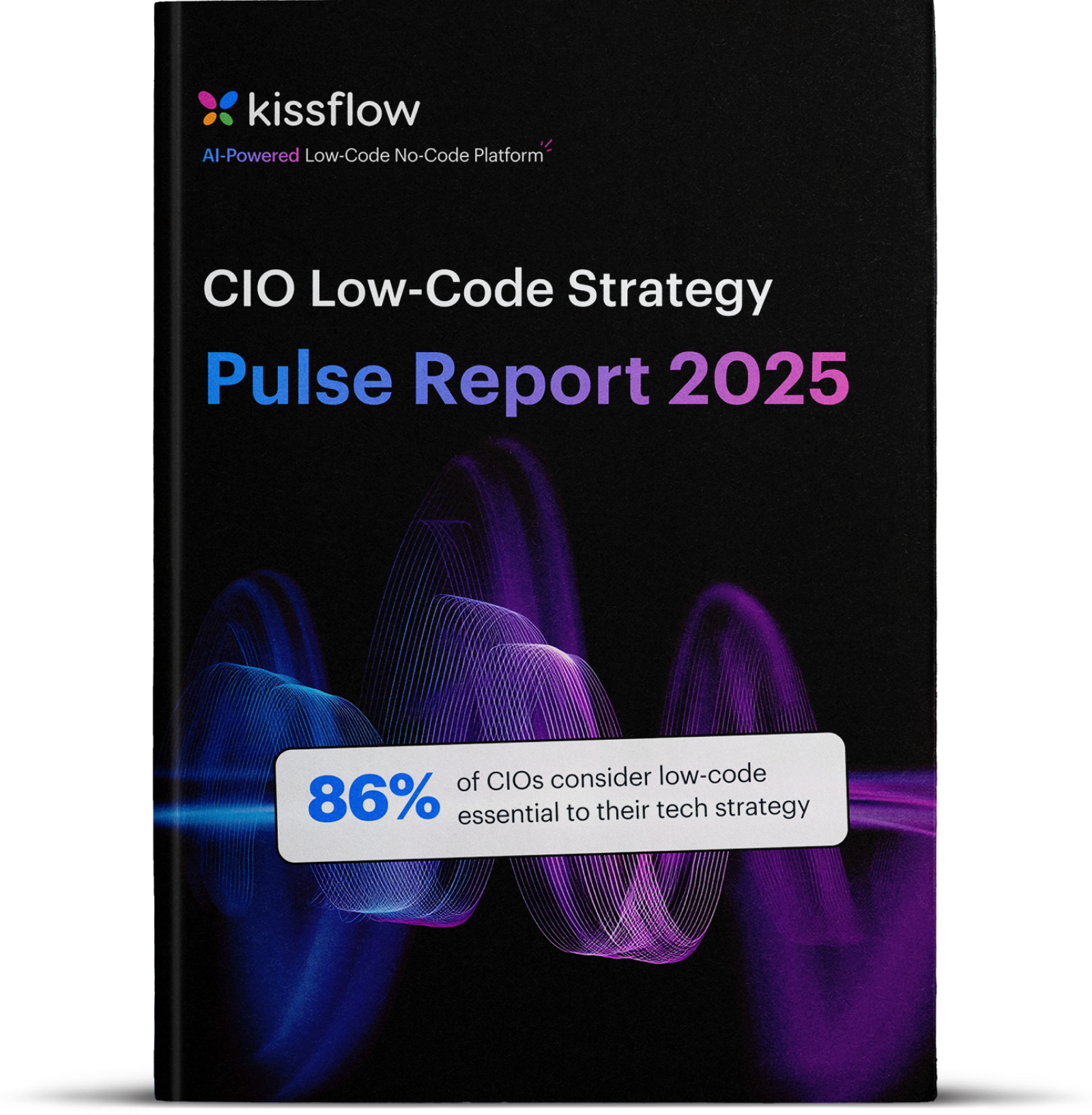How Will Low-Code and AI Coexist
It’s hard to be a market leader in an ever-changing digital market. Forward-thinking companies continuously innovate and automate to stay ahead of the pack. Want to gain a competitive edge in a fast-paced market? Harness the power of low-code and AI.
The global low-code development platform market will be worth $148.5 billion by 2030. Low-code tools can help enterprises streamline their processes and build the digital solutions they need at scale. According to Gartner, 70 percent of new applications will use low-code by 2025.
Artificial intelligence has transformed how businesses find production anomalies, personalize customer-focused messaging, automate processes, identify fraud and cybersecurity breaches, and more. AI’s value will grow to nearly two trillion US dollars by 2030.
Most low-code development platforms now incorporate AI, simplifying the development process. Together, low-code and AI can democratize application development and expand the horizons of software development. They empower subject matter experts to become citizen developers and participate in application development, driving innovation and efficiency.
Experience the power of low-code with the simplicity of no-code.
What are low-code and AI?
Low-code development allows professional and citizen developers to build applications with little or no coding. Visual interfaces, drag-and-drop editors, and pre-built templates make creating and deploying apps easier for users.
Artificial intelligence is the simulation of human intelligence processes by computer systems. AI systems are developed to think and act like humans and can function autonomously, producing desired outcomes without human intervention. They have a high capacity for learning and adaptation. They can automate repetitive learning and discovery through data.
Can low-code and AI coexist?
AI won’t replace low-code platforms but will complement them. It can’t replace low-code because it lacks the human creativity, intuition, and domain expertise required in programming. While it can simplify low-code development, citizen developers are still needed to make strategic decisions, solve business problems, and conceptualize complex systems.
When combined with low-code, AI can help users create agile apps, provide personalized experiences, and empower enterprises to make data-driven decisions. Citizen developers can give natural language prompts to low-code platforms to quickly develop apps.
AI-generated code cannot replace visual development
Non-developers still need a visual development environment (low-code) to build and deploy applications. The visual tools found in low-code platforms (like entity relationship diagrams and process diagrams) are still vital for building software, managing it, and understanding how it works. AI can be inadequate for application development as it is imprecise and inefficient at capturing complex ideas.
Experience the power of low-code with the simplicity of no-code.
The significance of low-code and AI’s coexistence
For many organizations, customization is a vital part of software development. Low-code platforms are ideal for business users because of their intuitive designs. When infused with AI, they help users optimize processes and build agile applications. Low-code is an accelerator for software development, while AI is an accelerator for low-code platforms.
AI-assisted low-code platforms democratize software development by empowering end-users with simplified coding abilities. IT professionals and non-technical users can harness AI automation to reduce errors, increase efficiencies, and eliminate repetitive work.
AI-powered low-code platforms leverage predictive modeling and real-time user behavior, leading to faster app development. When business users build applications with minimal IT support, development costs are lowered, and enterprises don't suffer from IT staffing shortages.
Enterprises in data-driven industries like marketing, sales, and finance can greatly benefit from low-code artificial intelligence platforms. AI can aid in automating invoicing, predicting churn rates, adding intelligent suggestions, analyzing reports, and much more.
The synergy between low-code and AI
Low-code and AI democratize software development, enabling professionals to rapidly build modern, scalable, secure software products and applications.
Here’s how low-code and AI work together.
Build AI-powered apps
Low-code AI enables rapid development and prototyping of applications. Non-technical users can leverage AI suggestions for application logic and workflow designs to create applications from pre-defined components quickly.
Expedite app development
AI-powered low-code platforms introduce code-free capabilities that expedite the development process. They facilitate quick prototyping and iterative processes, allowing for the incorporation of user feedback during the early stages of development. 87 percent of chief innovation officers say adding AI boosts their ability to fully leverage the low-code platforms' capabilities.
Automate AI development and deployment
Using AI, developers and non-developers can rapidly build and test applications. They can run tests with end users to check app functionality. Based on real-time user feedback, they can identify and deploy quality applications.
Democratize AI
Low-code AI development platforms are on the rise because they empower citizen developers to capitalize on the power of AI without extensive coding knowledge. They remove the need for coding skills and make AI development accessible to a broader audience.
Experience the power of low-code with the simplicity of no-code.
Implications for businesses
Low-code AI development has transformed how applications are built by offering a simple, intuitive, and user-friendly development environment. It gives enterprises ready-made building blocks for creating AI-powered apps, with users crafting apps in hours instead of days.
Businesses that utilize low-code AI tools reap numerous benefits. They enjoy massive cost cuts on development, increased time-to-market for their apps, enhanced user experiences, and better data analytics. They can drive efficiency and innovation and gain a competitive advantage. With the help of AI, businesses can achieve the customizations they need based on business problems and not a system’s limitations.
Technology should support your operational efficiency goals, and that’s where low-code AI development comes in. It supercharges your business operations. Non-technical employees create applications using drag-and-drop elements, developing ready-to-use apps in hours.
Enterprises can use low-code AI for:
- Building data wrangling and data extraction applications
- Creating applicant tracking systems for recruiting
- Creating payroll platforms for accounting
- Designing, automating, and optimizing end-to-end processes.
The best part? Implementing AI is financially viable. McKinsey reports that data analytics integration in business operations will bring in about $9.5–15.4 trillion annually, and AI systems will account for about 40 percent of the revenue.
Low-code AI challenges and opportunities
Challenges
Ethical decision-making
One of the primary challenges of low-code AI development is ethical decision-making. As AI systems become more autonomous, there are increasing concerns about accountability, bias, and privacy. The workings of AI systems are sometimes opaque and difficult to understand. It can create ethical dilemmas in scenarios where accountability is needed.
Data privacy and security
Since AI systems rely heavily on data, there are concerns about collecting, storing, and analyzing sensitive and personal data. Organizations using low-code AI must take measures to protect sensitive data from unauthorized access, data breaches, and cybersecurity threats. They must use tools that comply with GDPR and other data privacy laws to mitigate the privacy risks associated with AI systems.
Job disruptions
Investment bank Goldman Sachs reports that AI could replace 300 million full-time jobs. But some good news: AI will create new jobs and a productivity boom. Low-code and AI development will reshape the job market. While some roles—such as customer service, bookkeeping, and marketing—will be eliminated, new ones that require new skill sets will be created. Organizations must take proactive measures to upskill and reskill their workforce.
Opportunities
Boost efficiency and productivity
Low-code AI platforms automate repetitive tasks, enabling users to focus on complex, creative work. Organizations achieve higher productivity levels by streamlining processes and enhancing accuracy. AI algorithms can help companies identify patterns and trends to leverage opportunities.
Enhanced decision-making
AI tools can analyze vast amounts of data and provide valuable insights. They empower businesses to make faster, more informed decisions based on data. Real-time tracking and accurate prediction of industry developments enable companies to make data-driven decisions, leading to improved outcomes.
Personalized experiences
Low-code AI tools enhance user satisfaction by delivering customized solutions. For example, a low-code platform integrating a natural language generation tool can help users build apps with personalized messages or recommendations.
The future of low-code and AI
Low-code will play a crucial role as organizations seek efficiency and intelligent business solutions. Developers and non-developers will build and deploy applications with AI capabilities. In the future, we expect low-code AI platforms to improve, allowing users to create more sophisticated apps.
Gartner predicts that over 50 percent of all new applications will be developed using low-code tools in 2024. Another research by Forrester reveals that low-code development will reduce development time by up to 80 percent. Application development will be automated with the help of AI, and AI-powered applications will be more intelligent, quickly adapting to new circumstances.
Enterprises using low-code AI will significantly reduce application development costs and timelines. AI algorithms will guide business decisions, and applications will have the capacity to deliver insights and propose actions. Future organizations will use low-code and AI to raise the bar for application quality and provide end users with highly customized experiences.
Accelerate low-code development with AI
AI can revolutionize businesses, streamlining internal processes and enhancing customer experiences. However, infrastructure investment and a skilled workforce are needed to benefit from AI truly.
Fortunately, low-code AI tools like Kissflow Low-Code make AI accessible to everyone. IT teams and business users can harness the power of AI without delving into technical coding. Kissflow’s user-friendly interface, drag-and-drop features, and automation empower users to leverage machine learning and create innovative applications.
Use Kissflow Low-Code to accelerate development and rapidly develop and deploy AI-driven solutions. Test hypotheses, iterate quickly on ideas, and build a culture of innovation and problem-solving.
People also ask / FAQs
What is the future of AI?
Next-generation AI tools will relieve developers and non-developers of mundane, time-consuming tasks. The technology will speed up software and data development processes, boosting productivity and efficiency. Developers will have time to focus on more innovative, challenging tasks.
Will AI take over by 2025?
According to a report by the World Economic Forum, AI may displace 85 million jobs by 2025. Enterprises that adopt low-code and AI will transform tasks, jobs, and skills. And while this sounds scary, the report also says AI will create 97 million new jobs in the same period. Accountants, factory workers, paralegals, radiologists, and other professionals may have to acquire technical skills.
Where will AI be in 2050?
AI will completely transform software development, robotics, and other sectors. By 2050, we expect highly advanced robots that perform complex tasks with precision and efficiency. These robots will streamline work in many sectors—manufacturing, healthcare, automotive, agriculture, and even space exploration. Many experts predict that by 2050, AI will replace a large portion of the workforce. But what AI might do is empower the workers who use it, creating better job opportunities.
Will AI dominate the future?
AI will grow increasingly prevalent as technology develops, revolutionizing sectors. AI-driven automation will change the work market, creating new positions and skills. While some jobs may become obsolete, others will be more efficient as AI-powered automation provides new ways of doing them.
What is low-code AI?
Low-code AI is an application development model that empowers business users with limited coding knowledge to leverage the power of AI for building applications and solutions. Subject matter experts without technical knowledge use visual building blocks and AI suggestions to develop applications. Most low-code AI platforms have graphical user interfaces and pre-built integrations that streamline app development.
What is an example of a low-code AI tool?
Kissflow Low-Code is a good example of a low-code AI platform. It allows businesses to leverage generative AI capabilities and low-code technology to accelerate app development.
Will AI replace low-code?
No, AI will not replace low-code. AI complements low-code and simplifies software development. Low-code AI platforms demystify development, empowering non-technical users to streamline workflows. But as with any technology, it’s vital to understand its capabilities to reap its benefits.
How will low-code and AI coexist?
Low-code tools are ideal for iterative development. They enable cross-functional teams to collaborate on app development and iterate quickly. AI can simplify low-code by generating code snippets that can be refined, tested, and integrated.

Kissflow Low-Code
Get in touch with us to learn more about how you can transform your application needs.
Related Articles

What is Low-Code? A Complete Guide to Low-Code Development
Low-code is a software development approach that requires little to no coding ...

The Ultimate List: Best 8 Low-Code Platforms for 2025
The Best Low-code platform are making application development more accessible.

Kissflow Low-Code Platform
Turn your ideas into apps with Kissflow Low-Code Development Platform









